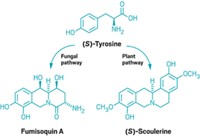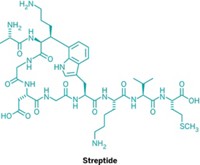Advertisement
Grab your lab coat. Let's get started
Welcome!
Welcome!
Create an account below to get 6 C&EN articles per month, receive newsletters and more - all free.
It seems this is your first time logging in online. Please enter the following information to continue.
As an ACS member you automatically get access to this site. All we need is few more details to create your reading experience.
Not you? Sign in with a different account.
Not you? Sign in with a different account.
ERROR 1
ERROR 1
ERROR 2
ERROR 2
ERROR 2
ERROR 2
ERROR 2
Password and Confirm password must match.
If you have an ACS member number, please enter it here so we can link this account to your membership. (optional)
ERROR 2
ACS values your privacy. By submitting your information, you are gaining access to C&EN and subscribing to our weekly newsletter. We use the information you provide to make your reading experience better, and we will never sell your data to third party members.
Biological Chemistry
Unique Enzyme Could Lead To Novel Antibiotics
Promiscuous transglutaminase in andrimid biosynthesis might yield improved analogs
by Amanda Yarnell
August 23, 2007

Recent efforts to characterize an unusual catalyst in the enzymatic assembly line dedicated to andrimid production could lead to new, improved analogs of this antibiotic, researchers reported at the ACS national meeting in Boston this week.
Speaking before a packed session of the Division of Biological Chemistry, Christopher T. Walsh, a professor of biological chemistry and molecular pharmacology at Harvard Medical School (HMS), described the action of AdmF, which catalyzes the formation of a key amide bond in the biosynthesis of andrimid. This potent antibiotic kills a wide range of bacteria by blocking a critical step in fatty acid biosynthesis.
Walsh reported that AdmF catalyzes the condensation of two protein-tethered substrates: the acyl group of a polyunsaturated fatty acid and the amine of β-phenylalanine (Nature 2007, 448, 755). He also pointed out that the enzyme can accept a variety of fatty acid substrates. This ???promiscuity??? suggests that the enzyme could be exploited to generate novel analogs of andrimid by feeding its biosynthetic cluster different substrates, he noted.
AdmF is structurally and mechanistically distinct from the two other kinds of condensation enzymes found in natural product assembly pathways. It belongs to a large enzyme family known as transglutaminases, which normally link peptides and proteins by creating bonds between the side chain carboxamide of glutamine and various amine donors. ???This is the first time a transglutaminase has been recruited for the biosynthesis of an antibiotic,??? Walsh said.
John Blanchard, an enzymologist at Albert Einstein College of Medicine, commented that ???it???s fascinating that nature has used a transglutaminase and arrived at the same chemistry??? as traditional condensation catalysts.
A team led by Walsh???s HMS colleague Jon Clardy last year isolated the gene for AdmF and the other genes responsible for biosynthesizing andrimid from Pantoea agglomerans bacteria (J. Am. Chem. Soc. 2006, 128, 10660). Walsh, who characterized the AdmF gene in collaboration with postdocs Pascal D. Fortin and Nathan A. Magarvey, pointed out that his team has found genes that resemble it in many other microbes. As such, he suggested, the unusual condensation mechanism of AdmF likely is not limited to andrimid biosynthesis.??????





Join the conversation
Contact the reporter
Submit a Letter to the Editor for publication
Engage with us on Twitter